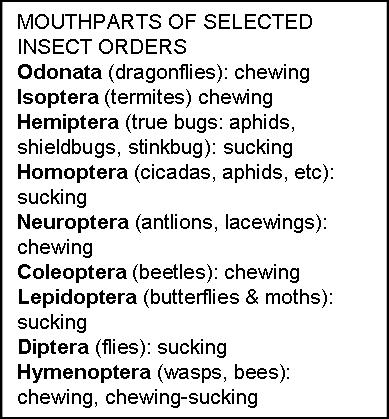Insects by Mouthparts
By Marilyn Sallee, Master Gardener - Entomology Specialist
As gardeners we know that, by far, most insects are good for the garden, even essential. We need the insects to pollinate the plants and disperse seeds. But a few insect traits give the whole class Insecta a bad reputation. We need to be able to tell the bad guys at a glance, and the key trait to do that is mouth parts and the damage they do.
Insects with sponging mouth parts cannot bite or chew. If you ever saw the movie ďThe FlyĒ, you might remember how he would slurp
at the bowl of milk and honey. You can think of this mouthpart as a sponge on the end of a straw, and is most common in certain types
of flies that slurp up liquefied food. That might be decaying fruit or rotting veggies, maybe even blood that is already exposed.
These flies might carry disease or be a nuisance, but they canít bite or chew, so they donít damage plants. (Note: some ďfliesĒ
have blades, like a horsefly, or teeth, like a tsetse fly. (See their mouthparts above.)
Siphoning mouth parts are most common in butterflies
and moths. They have a long tube which they usually carry curled up. It works like a straw, so they can insert it deep into tubular
flowers and drink nectar, or sip puddles of water for dissolved minerals. They can suck but they canít bite or break tissue, so they
donít do damage.
And then there are a few insects that, in their adult form, do not even have mouths. Once they reach adult stage,
the only thing they can do is mate and lay eggs. For example, the Promethean Moths live their entire but brief adult lives from food
stored as a caterpillar, and the adult Mayfly lives less than one day with an empty digestive system and vestigial, useless mouth.
Neither
sponging nor siphoning mouthpart insects cause direct damage in the garden. Enjoy them for the pollinators they are.

The chewing insects are the most damaging ones, since they eat the plant materials directly, but the damage is an excellent clue for
what to look for. Chewing damage can be inside a leaf, such as the tunnels left my leaf-miners that look like pale, wiggly lines all
over the leaf. Or the damage could be as great as entire missing leaves or even totally defoliated plant. The caterpillar, which is
the larva form of a butterfly or moth, can eat down its host-plant in a few days. The good news is that the most damaging are usually
also the largest and easy to spot and remove by hand.
The kind of damaged caused by the chewing insect is usually sufficient to identify
the type of insect, even if you canít see the insect, and thus how to stop it. For example, the wilting leaves on a squash plant can
identify the squash borer hidden inside, eating the stem. As with the piercing insects, the chewing insects may also contain some
friends. Ladybugs have chewing mouthparts, but what they like best to chew on is not plants, but the aphids that are sucking the juice
out of the plants.
The bottom line here is that insects in the garden are usually beneficial. Itís not the actual insects that you should look for, but the damage they cause. The type of damage is usually sufficient to identify the type of insect causing it. Armed with that knowledge, you can then use Integrated Pest Management (IPM) to target that damage-causing insect directly without disrupting the good guys in the garden.
(Note: above graphics from Univ. of Missouri Extension Service)
These insects are definitely out to do damage. They have a hard beak to puncture tissue and suck out the liquid contents below. The
mouth is usually a long, slender stylet in a hard sheath.
That may be the mosquito that pierces your skin to suck out blood, the aphid
that sucks out plant sap, or the shieldbug that pierces the tomato to suck out its juice. The damage they cause is usually a spot
or bump. They can also inject toxins or disease organisms into the location they pierce.
Once you find the damage, these are usually
easy to spot by looking for the piercing mouthpart. But not all of piercing mouthparts insects are the enemy in the garden. Many of
our best insect-controls are other insects, such as the Assassin Bugs, that use their piercing-sucking on other insects.

Damage Causing (maybe):
Piercing-Sucking
Damage Causing:
Chewing
Can't bite:
sponging,
siphoning or
no mouth at all



